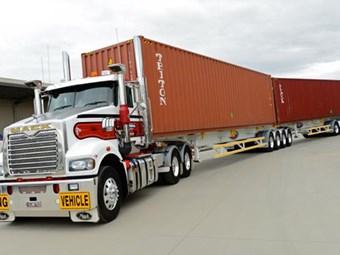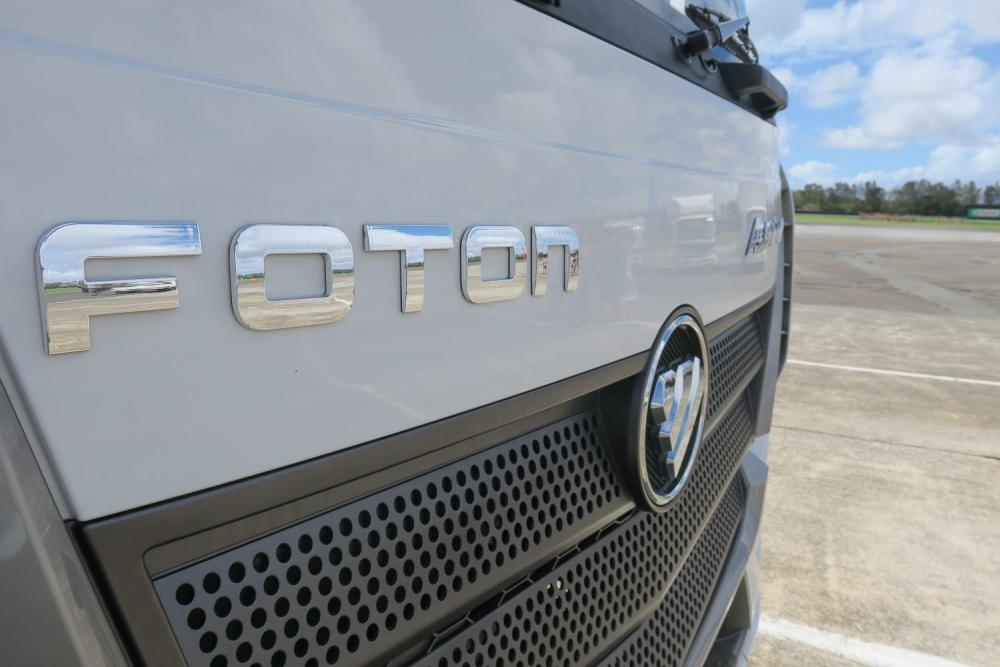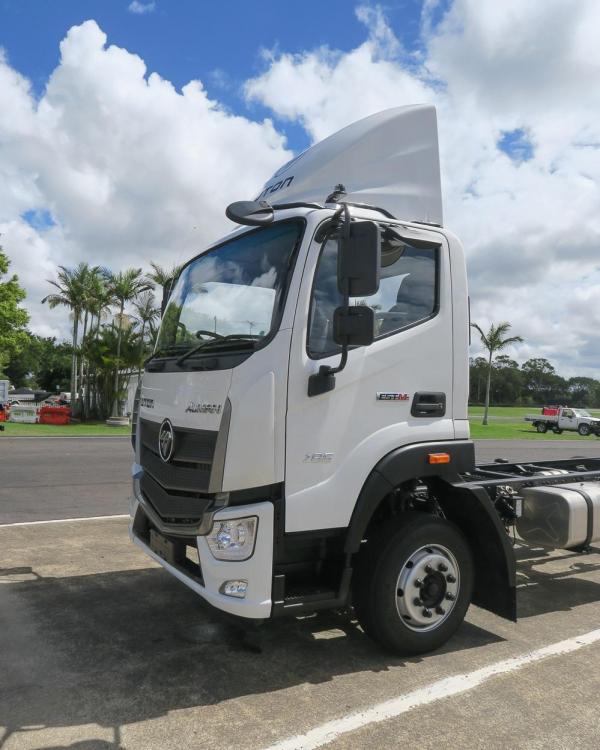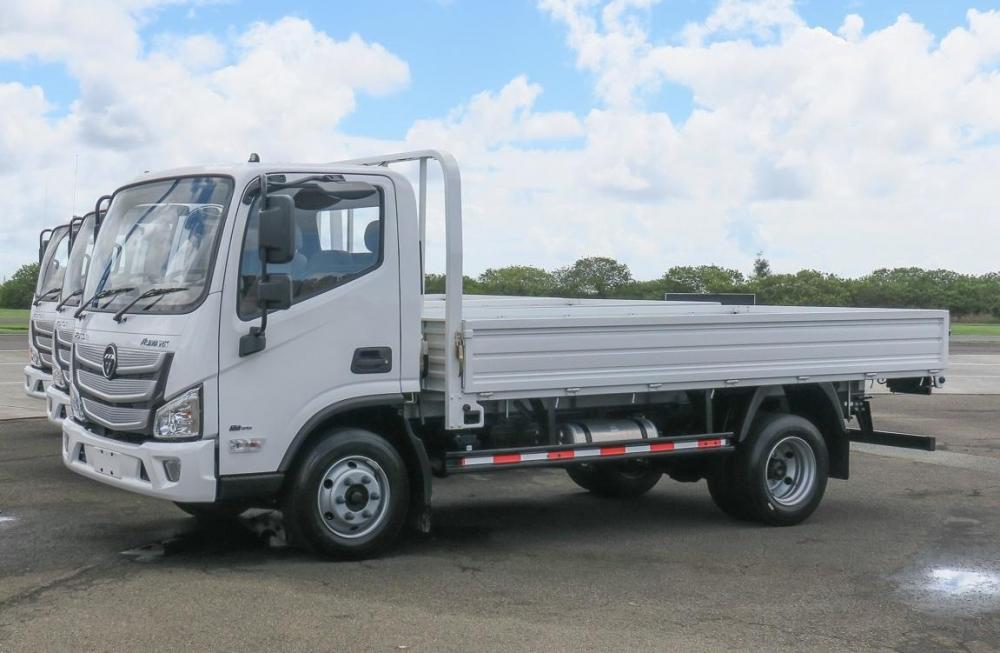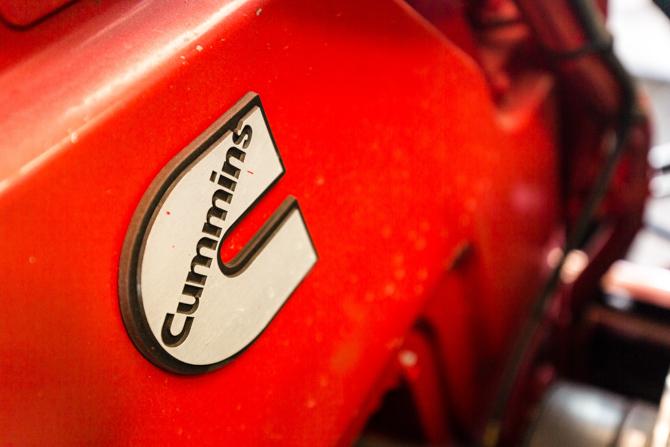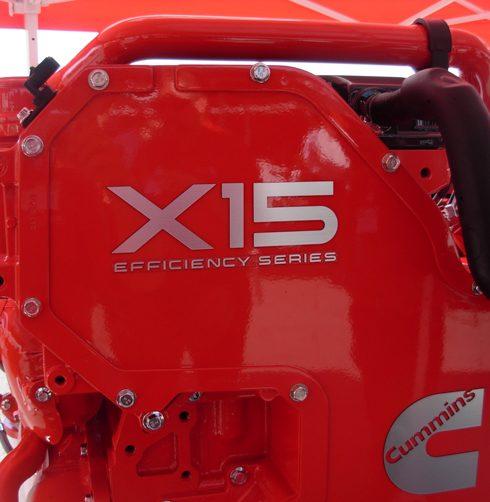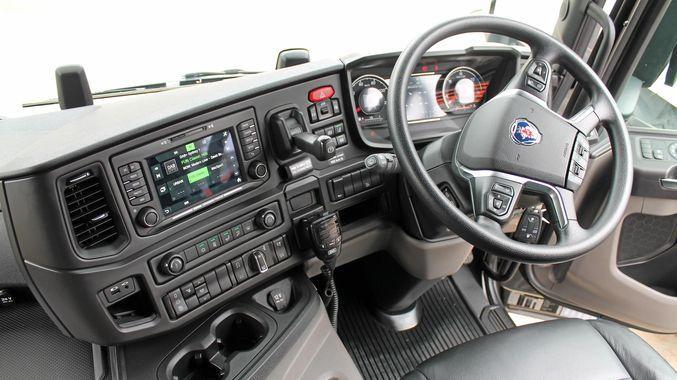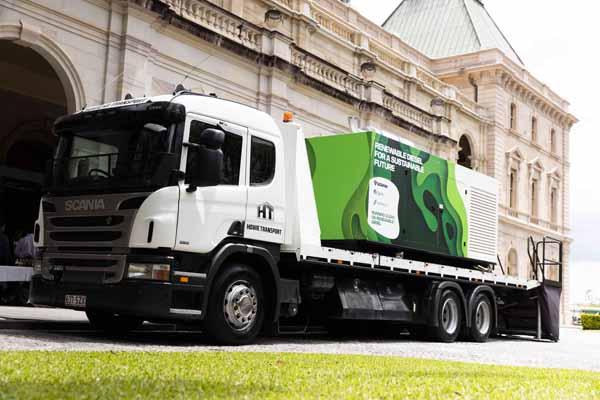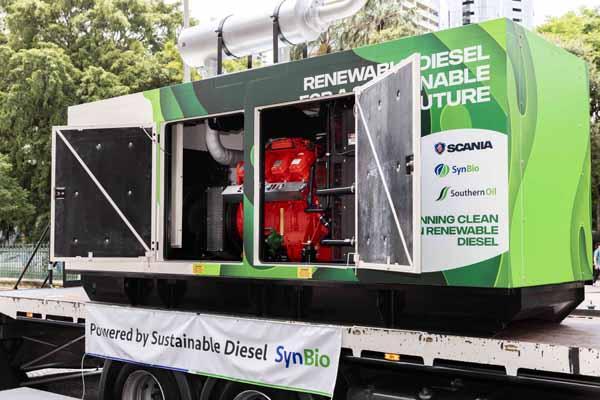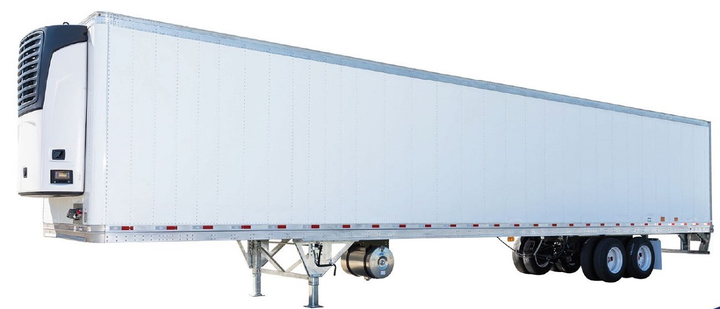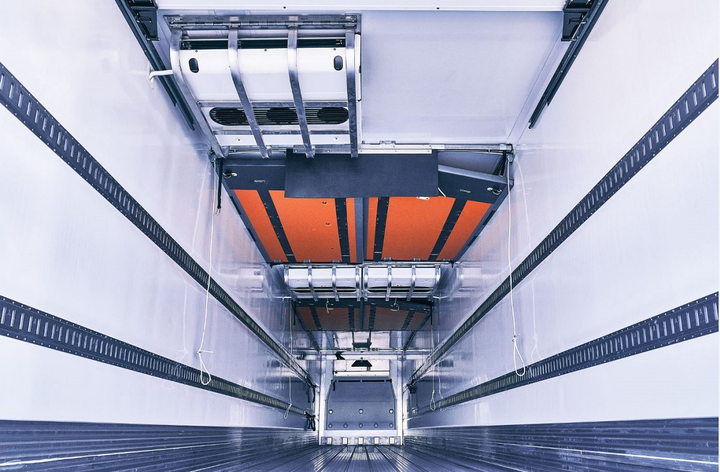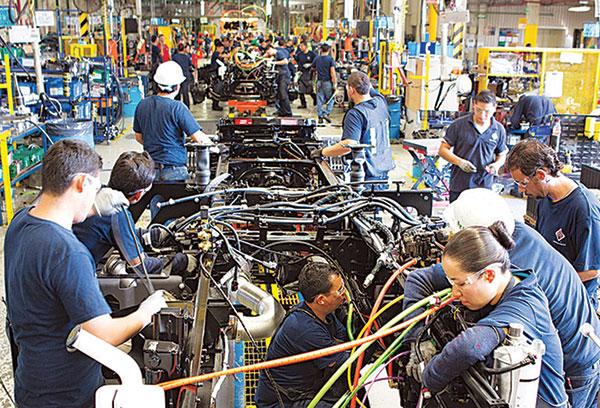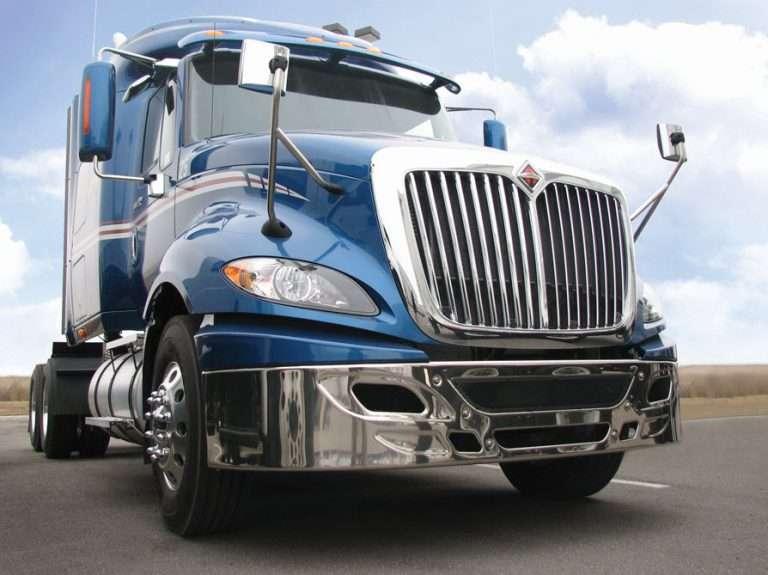
kscarbel2
Moderator-
Posts
18,545 -
Joined
-
Days Won
112
Content Type
Profiles
Forums
Gallery
Events
Blogs
BMT Wiki
Collections
Store
Everything posted by kscarbel2
-
International Trucks Press Release / April 3, 2019 .
-
Ford thought the global EcoSport was too spartan and decided to revamp the interior before introducing it in North America. I drove it overseas and thought it was fine......never could understand their decision. Also, Ford originally thought the EcoSport (alike the Ranger) had no place in North America.
-
Volkswagen launches all-new Delivery light truck range
kscarbel2 replied to kscarbel2's topic in Trucking News
I have suggested it to Navistar management. Alike Chevrolet Commercial, NAV would offer both the CV conventional and the Delivery low-cab-forward. -
FORD: Trucks can't overcome car slump Richard Truett, Automotive News / April 2, 2019 Ford's March U.S. sales dropped 5.2 percent with sharply weaker car demand offset by slightly higher truck deliveries, according to the Automotive News Data Center. Lincoln logged another quiet month with sales ticking up 1.9 percent. If there were two breakout stars on the showroom floor, it was the Ranger midsize pickup and the EcoSport crossover. And a hat tip to the Fiesta for a strong month, even though the end of the road is near. Lincoln's new Nautilus is off to a good start, but otherwise, not much is happening in Ford's luxury division. Brands: Ford, down 5.5%; Lincoln, up 1.9%. Notable nameplates: EcoSport, Ford's smallest crossover, continues its winning streak with sales of 5,244 units. For the quarter, Ford sold 12,879 EcoSports, up 111 percent over 2018's first quarter. The Fiesta, running on fumes as the clock winds down on the entry-level hatchback, racked up March sales of 7,299, up 47 percent year over year and 29 percent for the quarter. Another Ford car slated for burial, the midsize Fusion sedan, also saw sales rise in March, with 18,008 sold, up from 16,103 a year ago. On the truck side, the F-150 held its ground against the recently revamped Ram from Fiat Chrysler and the Chevrolet Silverado and GMC Sierra from General Motors. U.S. sales of the F-150, the industry's best-selling nameplate, totaled 86,497 last month, down from 87,011 a year ago. For the quarter, sales were stagnant, but still an industry best at 214,611, down 0.2 percent over a year ago. The Ranger's return has been nothing but good news for Ford. The midsize truck chalked up sales of 4,369 units in March, according to the Automotive News Data Center. But two of Ford's bread-and-butter SUVs, the Escape and Edge, posted March declines. At Lincoln, March can best be described as sleepy. Sales of the brand's utilities rose 10 percent, a gain canceled out by a 19 percent decline in car deliveries. The Nautilus SUV was Lincoln's star performer in March, with sales of 3,019. Ford and Lincoln sales figures for March are provided by the Automotive News Data Center. Q1 2019 U.S. light-vehicle market share: 14.7% vs. 14.5% in Q1 2018. March incentives: $3,954 per vehicle, down 5.1%from a year earlier, ALG says. Average transaction price in March: $39,183, up 4.8% from a year earlier, according to ALG Did you know? Though Mustang sales were down in March, that could change starting now. Traditionally, sales of sporty cars pick up in the spring, jump-started oftentimes by added incentives. Mustang's strongest months are usually April to August. Sales of sporty cars have been weak as the market shifts from cars to crossovers, trucks and SUVs. We'll be watching closely to see if Mustang gains ground as we round the corner into summer.
-
Ford Trucks Brasil: a breath of hope? Transport Brasil / April 2, 2019 Grupo Caoa announces purchase of Ford operations in São Bernardo do Campo and wants to continue manufacturing trucks under US brand license The legendary Ford Trucks is heading for a happy ending: after leaving the market stunned by its withdrawal in South America and threatening to eliminate more than 3,000 jobs, the company is, according to the newspaper O Estado de São Paulo, closing a sales agreement for Grupo Caoa, which already distributes the Subaru, Hyundai and Chery brands in Brazil. According to newspaper sources, Caoa is interested in manufacturing Ford's trucks under the brand's license. Production of the Ford Fiesta hatch would continue. In Goiás, in the industrial city of Anápolis, Caoa has a large industrial complex where it manufactures the Hyundai HR and HD80 trucks, as well as the Hyundai Tucson and iX35 SUVs. There, the new Chery Tiggo 5X and Tiggo 7 are also made. Help from the São Paulo government When Ford announced the closure of its truck plant, the São Paulo government, led by Governor João Dória, began work to find a buyer for the operation, thinking about preserving jobs. With the help of the governor and with interest in the Ford factory, Caoa Group expressed an interest in the São Paulo operation. The company said in February it had a strong partnership with Ford four decades ago and that "it would be natural for Caoa and Ford to talk about future deals." Nothing official yet Caoa and Ford have not yet confirmed the news and a Ford spokesman refused to discuss the matter. However, the news check with industry sources confirms the fact. Plans with VW In addition to having a new commercial truck joint venture in Brazil with Caoa, Ford’s plans also include a partnership with Volkswagen. The idea is to develop medium-size pickups and commercial vans together from 2022. The first fruit of this partnership will be the new Ranger, which will include a Volkswagen version. In addition, Ford and Volkswagen have already stated that they will work together on the development of electric vehicles, as well as investing in the development of autonomous vehicle systems. Scenes from the next chapters It remains to be seen how the customers of Ford Trucks and their thousands of vehicles in circulation throughout Brazil will remain. How will the dealer network be structured? And the jobs?
-
Volkswagen launches all-new Delivery light truck range
kscarbel2 replied to kscarbel2's topic in Trucking News
The Delivery light truck range from Volkswagen Truck & Bus. Tailor-made for your business. Click and learn more: https://www.novodelivery.com.br/ . -
Australasian Transport News (ATN) / April 2, 2019 Combinations up to 30m included in pre-advised design approval process The National Heavy Vehicle Regulator (NHVR) has expanded the performance-based standards (PBS) pre-advised design approvals in its latest update. From April 1, 2019, the PBS pre-advised design approval process includes qualifying B-double combinations up to 30m. The scope of pre-advised specifications for truck and 3- or 4-axle dog and prime mover and semi-trailer combinations has also been broadened to include Level 2. NHVR chief engineer Les Bruzsa says the pre-advised process is improving processing times. "Since the commencement of the pre-advised design approval trial in March 2017, application processing times for applicable vehicle types have reduced on average from four weeks to three business days," Bruzsa says. "To date, most major combination designs have been pre-advised and it is estimated that 90 per cent of all PBS design applications will qualify for approval under the simplified pre-advised design approval process." More on the update can be found here. .
-
The New Kenworth T410 and T360 on the Move Diesel News Australia / April 2019 Here is a short video giving us a bit more of a look at the new Kenworth T410 and the T360 on the move, taken at the recent showcase of the new trucks at Anglesea in Victoria. The introduction of these two new models means the Kenworth brand has a modern state-of-the-art truck throughout its main range, apart from in cabover. Of course, it will continue with these outliers in terms of cabovers, the very top of the range and road train prime movers, models like the K200, T659, T909, T509 have a specific market and are not set to change anytime soon. Of course, the K200 and the T909 are popular sellers, but Brad says there are concrete plans to launch any replacement any time soon. However, modernisation must be on the drawing board for these two, at least. As usual the Paccar organisation will play its cards very close to its chest and the K200 and T909 are too important to be tinkered with lightly. However, for now a truck buyer looking for anything from a heavy duty rigid with a nine litre engine all the way up to a road train prime mover with a 15 litre engine has the option of going the next step with a modern conventional Kenworth truck. Video - https://vimeo.com/328278126
-
Diesel News Australia / April 2019 The Australian truck market is witnessing the return of Foton, as the Chinese truck maker introduces a new range of trucks into the light and medium duty truck market. Two models are slated for release in the coming months. There have been a couple of previous appearances for the Foton here in Australia, but this time the Chinese parent company is involved, bringing its own people to Australia to get the brand kick started. There are two truck models coming into the country, the Aumark and the Auman. The Aumark is the more familiar light duty offering and the Auman is the name used for the truck maker’s higher GCM models right up to heavy duty prime mover size. The new models coming onto the market in 2019 are the Aumark S and the larger Auman EST In China, Foton is involved in a close relationship with Daimler Trucks and this relationship can be seen in the design of the front grille on these new trucks. It is very reminiscent of the Mercedes Benz grille on the new range of trucks introduced here back in 2016. There is also a joint venture with Cummins which provides the 3.8 litre engine in the Aumark S, which comes on stream in the next month or so, here in Australia. Power is 150hp. It will be available as both a 4.5 tonne GVM and a heavier 7.5 tonne version. This model is a considerable upgrade on the Foton models we have seen on the Australian market before. The new electronic architecture, which comes along with the new modern Benz-like look, brings with is electronic stability control, ABS, hill start assist and lane departure warning. These are all features which are becoming the standard in the more modern Japanese trucks in this market. The gearbox comes from another of Foton’s joint venture partners, ZF. The German transmission specialist’s six speed manual gearbox is offered in the Aumark S. With disc brakes all round, the Aumark uses a full air braking control system. This is consistent with all of the other Chinese truck manufacturers who have dipped a toe into the Australian trucking waters. Later in the year we will see the appearance of the Foton Auman EST, a much more ambitious move into the Australian truck market. This is a 12 tonne GVM model and a first for a Chinese manufacturer here in Australia, a move into the medium duty market. This is currently slated to make its first appearance on the market in June. Power on this model comes from a 4.5 litre Cummins ISF with 185hp on tap. This drives through another, but heavier, six speed transmission from ZF. The new trucks’ first appearance in Queensland saw the Foton team put a number of examples of different body options on display to suit the Aumark S, but only a cab chassis configuration on the larger Auman. Body options will come along later. The new body shape and grille does make these trucks look much more modern than their clunky predecessors. The new CANbus electronic architecture does enable the manufacturer to plug into all of the latest technology. The question will be, and it always is with the launch of a Chinese brand, just how well does the truck suit our market and does the truck maker understand the Aussie truck buyer enough to reach the kind of modest sales targets the company is setting for itself. .
-
Diesel News Australia / April 2019 Celebrating its 100th year as a company in 2019, Cummins is to showcase its past and its future as it showcases a range of legacy and future engines at the Brisbane Truck Show. “This will be one of the most impressive collections of Cummins engines ever displayed in Australia, ranging from a 3 hp, single-cylinder 1922 unit to our 600 hp X15 coupled to the all-new 12-speed Endurant automated transmission,” says Mike Fowler, Cummins South Pacific’s Director of Engine Business. A Glimpse into the Future The two X15 engines and one X12 at the Brisbane Show will be Euro 6 versions which are expected to become available in Australia and New Zealand in 2020. Both the 12-litre and 15-litre Cummins platforms are EGR-free for Euro 6, using SCR/AdBlue technology along with a diesel particulate filter (DPF) for compliance. The X12, rated at 500 hp and 1700 lb ft of torque, achieves the highest power to weight ratio of any engine in the 10-to-16-litre class and will soon become available in a truck chassis in Australia. Two versions of the X15 Euro 6 engine will be on display at Brisbane – the Efficiency Series and Performance Series – and each has a different set of hardware and software to achieve its objectives. “They are two separate platforms that will allow customers to optimise their engine to best meet their needs without compromise,” says Mike. The X12 and Efficiency version of the X15 will be coupled to the all-new Endurant 12-speed automated transmission, the first heavy-duty automated transmission to emerge from the joint venture Eaton Cummins Automated Transmission Technologies business. “This is a game-changing transmission featuring a sophisticated communication system between the engine and transmission software,” says Mike. A key element of the ‘Cummins Integrated Power’ solution, Endurant is engineered to support engine downspeeding to help save fuel. It features predictive shifting using look-ahead technology to execute shift decisions at the best rpm for fuel economy while maintaining good on-road performance. The X15 Performance engine at the Brisbane show will be coupled to an Eaton 18-speed UltraShift Plus automated transmission. A Blast from the Past The legacy line-up at Brisbane will feature what is believed to be the oldest Cummins engine in Australia, recently discovered near Toowoomba in Queensland. A single-cylinder unit that squeezed out 3 hp at 600 rpm, it is thought to have been built in the first half of 1922 under a license granted by Robert M Hvid who owned the US patents for the fuel and combustion system. Other legacy engines will include the C160, the first Cummins engine to significantly advance diesel power in Australian trucking. A 464 cu.in. (7.6-litre) naturally aspirated in-line six, the C160 produced 160 hp at 2800 rpm. Cummins’ most successful V-series engine, the 903, along with some notable in-line sixes – the NTC350, N14 ‘Red Head’ and first-generation Signature 600 – will also be on display to stir the emotions of Cummins aficionados. .
-
Joel Helmes, Big Rigs / April 4, 2019 A LOT of focus has fallen on the technology that features in the new-generation Scania truck. But really, that's only half the story. What perhaps hasn't been highlighted well enough is the drivability and ease of use delivered by this truck. I've sampled the new Scania in a couple of different configurations, including single trailer, B-double and B-triple, but just recently I got some time behind the wheel of this rigid - the P 360 8x2. Piloting the Scania around the streets of southwest Sydney, the Scania is just a breeze to drive. Your biggest challenge is remembering you're driving a 16-tonne vehicle. The first thing you notice is the eerily quiet cab. Turn the key and the 9-litre Scania engine kicks into life and while you can hear the engine running, you almost have to consciously listen out for it. Visibility from the driver's seat is excellent and is aided further by a full array of fully electrically adjustable mirrors. Seated comfortably in your leather-wrapped seat, complete with left arm-rest, the Scania brings creature comforts that we thought we might never see in heavy vehicles just a few short years ago. Features like Digital Radio (DAB+), including a function that automatically scans for radio stations as you move from region to region, auto headlights and auto wipers, and time-based heated mirrors, all add to the premium, driver-focused, feel. The steering in the new Scania takes some getting used to, it's light and with very little play off centre, the feel is more passenger car than truck. Manoeuvring the big Swedish machine around the very many roundabouts dotted across my test route, the 8x2 rigid had little trouble swinging around the bends. There are three drive modes to select with the 360hp (@1900 rpm) and 1700Nm (from 1050 rpm) engine/12-speed Opticruise combo surprisingly enthusiastic when Power mode is selected. The truck, with just under 4.7 tonnes of load, was comfortable in the "standard” setting, though more right foot enthusiasm was required on any sort of incline. Owners can select whether they want to have the Power mode activated on their truck, some might not if they're concerned drivers might run around full-time in the "top” setting and therefore chew up more fuel. That's for you to decide. I started my review of the Scania P 360 with a mention of the technology built into this truck and I believe anyone taking delivery of a new Scania should take the time to really get to know what it offers. Some systems and aids are obvious, others you might only discover with the help of someone in the know. For example, the Scania features a system called Downhill Cruise Control and this works simply with a touch of the brake pedal. Designed to help you keep the truck at a safe and steady speed when negotiating a downhill grade, you simply bring the truck down to the speed you want to utilise, push the brake pedal and the system is engaged. You get a confirmation that the function is working by way of a green light on the dash, then take your feet off everything and let the retarder, transmission and brakes do the rest. The five-stage retarder fitted to the new Scania is pretty awesome. It provides you with enough variation between the different stages to allow you to take off a bit of speed, or even just about bring the truck to a complete stop. If you're into saving your brakes the retarder should help you get a long life between relines. Some of the other clever tech includes a "manoeuvre mode” that helps control the clutch for smoother low speed manoeuvres, such as backing up to a trailer or loading dock. There's also front and rear air suspension height adjustment and this enables you to lift or lower the front and rear of the truck with the push of a button or two. And on the remote-control key fob you can switch on the truck's headlights - a great way to find your truck in a crowded yard. You can push another button and start the light test function so you can be sure everything is hunky-dory before you climb into the cab. Remarkably, these are just the start of some of the clever features and functions of the Scania. Speaking of the Scania cab, climbing in and out is a safe and easy affair because the designers did something rather clever - they cascaded the steps out and this means when looking down you can see each step ... so no more feeling around with your foot. I haven't forgotten an important aspect in a truck design - the features and functions when a rest is required. The P Series cab doesn't have a flat floor, that means it's a bit of a climb into the bunk. Once back there though you have a handy little LED reading lamp and USB outlet. There's also a clever little pouch to store your phone while you have a kip. I was glad to see Scania hadn't overlooked one must-have feature in a sleeper cab - a curtain that separates the main cab from the bunk. Perhaps the only thing missing back in the sleeper, and something you might be used to, are side-mounted air-vents/ports. There's a pop-top sunroof overhead and a slide-out fridge underneath the bunk while the many storage lockers/nooks around the Scania cab are well-sized. Summing it up: Scania went back to the drawing board with this new-generation truck and you can see the attention to detail that they've put into the finished product. True, it might not be to everyone's taste, however if I was spending eight or more hours in a truck cab each day this is the kind of vehicle that I would be choosing. Safe, efficient, comfortable and smart, the new Scania really is a game changer. .
-
Power Torque Magazine / April 2019 An Australian-first trial using 100 per cent renewable diesel to fuel a Scania V8 stationary engine in power generation is up and running. The joint development between the Palaszczuk Government and Southern Oil’s Advanced Biofuels Pilot Plant at Yarwun, near Gladstone, is pioneering the refining of renewable diesel fuel made from waste plastic, old vehicle tyres, agriculture and forestry waste, and biosolids. The Scania V8 test engine is being used in its power generation configuration for the testing – allowing assessment of exhaust emissions, performance and response, fuel efficiency, cost and engine lifetime. Premier Annastacia Palaszczuk said a state-based renewable fuels industry would underpin Queensland’s domestic fuel security for decades to come. “Over the next 12-to-18 months, Southern Oil will be trialling renewable diesel in the test engine to show it performs identically to petroleum-based diesel in terms of performance and wear-and-tear on the engine. “Southern Oil is also aiming to build a commercial-scale renewable fuel refinery within five years, which would create significant job opportunities and improve domestic fuel security for our state. Minister for State Development, Manufacturing, Infrastructure and Planning, Cameron Dick said the Palaszczuk Government is committed to delivering a $1 billion sustainable and export-oriented biotechnology and bioproducts sector by 2026. Before warranty is secured, an estimated one million litres of the renewable diesel will be trialled at Southern Oil’s advanced biofuels laboratory – the leading facility of its kind in the Southern Hemisphere. Southern Oil Refinery and SynBio Managing Director Tim Rose said Queensland is leading the country in biofutures and renewable fuels. “We’re witnessing the first step toward proving renewable diesel refined in Queensland from waste products can be chemically indistinguishable from petroleum-based diesel,” Mr Rose said. “Having a company like Scania endorse our fuel is crucial to creating commercial demand for our diesel and moving from pilot scale into demonstration scale. “Today’s demonstration shows there’s a huge opportunity to produce 100 per cent renewable diesel fuel in Queensland from waste. .
-
Truck News / April 3, 2019 HAGERSTOWN, Maryland — The Volvo Group’s Hagerstown powertrain manufacturing facility received $1,180,400 in rebate incentives from Potomac Edison for a number of energy efficiency upgrades. Since 2016 the facility has saved the equivalent of 9,158,862 kilowatt-hours of electricity, enough to power 759 average homes for a full year. “Becoming more energy efficient is part of our DNA here in Hagerstown, and it is incredible to see our progress in recent years,” said Pierre Jenny, Volvo Group vice-president of powertrain production. “We are proud to work together with Potomac Edison to cut our energy usage and in turn reduce our environmental footprint.” Since 2016, the Hagerstown facility has upgraded plant lighting to more efficient LED lights. More than 2,700 inefficient fixtures have been replaced with highly efficient LED fixtures and lighting controls. The facility also upgraded equipment used to manufacture engine crankshafts, including crankshaft grinding machines that require less energy. New induction hardening equipment, which is used to heat the crankshafts to optimize their hardness during the production process, was also installed and not only reduces energy consumption, but also delivers faster heating and reduced cycle times. The rebates are part of the EmPOWER Maryland energy efficiency program that offers rebates to Maryland-based commercial and residential customers that upgrade to more energy-efficient equipment. A one-time rebate is awarded to the customer to offset the cost of the upgrades they have completed at their residence or business. “Potomac Edison is committed to helping organizations make a meaningful impact on the environment through energy efficiency,” said Todd Kirkpatrick, manager of commercial and industrial energy efficiency programs for FirstEnergy. “The energy savings accumulated by the Hagerstown facility since 2016 are substantial, and we are pleased to have played a role in making it a reality.” .
-
Heavy Duty Trucking (HDT) / April 3, 2019 Hyundai Translead has launched a new HT ThermoTech refrigerated trailer designed for greater durability, increased thermal efficiency and lighter weight. The refrigerated trailer was designed to comply with new regulations about maintaining temperature in an efficient manner. Structural components that give refrigerated products their load carrying capacity can work against thermal efficiency because they transfer heat through the insulation. Hyundai Translead has used a new structural design that minimizes the effects of heat transmission. In some cases the structure mass has been designed so the insulated panels can include more insulating material. To reduce efficiency loss from moisture saturation, the trailers joints and closures were eliminated or improved to be less dependent on caulking and sealings, preventing moisture intrusion and maintain efficiency longer. Primers and bonding techniques are incorporated in the manufacturing process to assure the integrity of laminations between sheet materials. Preventing bonding separation between the outer skins and the insulation will discourage water gain due to condensation. The company also took steps to address longevity by redesigning the components most susceptible to damage. The deck now uses taller, stiffer structures to support the floor surface. Heavy duty aluminum floor extrusions fit together with a mechanical lock to take stress off the welded joints, and the new fully automated welding fixture lays down a weld-bead of greater mass for additional strength. All wood structures within the deck were removed and replaced with sustainable recycled materials that will not absorb moisture and increases fastener retention. The combination of material choice and design ingenuity allowed 13% greater floor ratings with no weight addition. Structural floor sills have been redesigned with rigid PVC, a more durable and recycled material. In addition to material changes, the floors also feature a new “mechanical lock” design, so floor pieces are secured together even prior to welding. “The improvement is to put a mechanical lock in the design so that when you connect the two pieces together we actually have a big advantage in the mechanical fit of these two pieces together even before we weld it,” said Adam Hill, vice president and a lead chief engineer for Hyundai Translead. While increasing thermal efficiency and service life of the HT ThermoTech reefer, all insulated panels were optimized to reduce weight. Sidewalls, roof, deck and front assemblies are lighter by converting to lighter weight raw materials or applying design techniques that require fewer components or leaner assemblies. The redesigned HT ThermoTech trailer is 600 pounds lighter for base line-haul models. “We have invested significant capital expenditures and made improvements to refrigerated trailers to be competitive and we will continue to invest and be innovative,” said , Hyundai Translead CEO Bonjae Lee. .
-
Truck orders fail to hit 20k units for third straight month Jason Cannon, Commercial Carrier Journal (CCJ) / April 3, 2019 North American Class 8 truck orders hit 15,200 units in March, according to FTR – the third consecutive month with order activity below 20,000 trucks. March 2019 was the lowest March order total since 2010, was 8 percent below February and down 67 year-over-year. Another analyst said March marks the fourth consecutive month with orders falling meaningfully below the current rate of build. “Over that four-month period, Class 8 orders have been booked at a 194,000 SAAR, (seasonally adjusted annual rate) compared to a 489k SAAR for the same period a year ago,” “These are extraordinary market conditions. Most fleets ordered well in advance of their need for trucks in 2019,” adds Don Ake, FTR vice president of commercial vehicles. “OEM production slots were scarce in 2018 and supplier constraints caused disruptions in supply, so fleets didn’t want to get shutout this year. Now so many build slots have been reserved, fleets that are currently placing orders for delivery this year don’t have many options.” Class 8 orders for the past 12 months have now totaled 397,000 units. Truck demand is still strong, but with all choice build slots filled for this year, Ake says fleets that need trucks are basically taking whatever is available. Backlogs are also rapidly declining as the market tries to rebalance and establish some semblance of normality. “Even though the economy and freight growth appear to be slowing, it has not impacted OEM line rates as of yet,” Ake says. “Fleets are still putting more trucks in service and competing in a still decent freight market. It is expected that Class 8 sales will moderate sometime before the end of the year, as industry capacity begins to catch up with the freight surge that began in 2018.” Even though demand is a shadow of its 2018 self, one analyst said slowing order intake masks current conditions. “Admittedly, economic and freight growth are slowing, but both are still growing,” he said. “And in the context of retreat from record levels, it is no wonder truck buyers continue to pursue incremental profits, as evidenced by the number of unbuilt units in the backlog.”
-
With build slots scarce, Class 8 orders continue to slow Josh Fisher, Fleet Owner / April 3, 2019 Although the economy and freight growth appear to be slowing, OEM line rates have not been impacted yet. Class 8 tractor orders continue to be sluggish compared to last year’s boom, according to two research firms that track heavy-duty truck sales. Demand is still strong, but supply is limited with all of the choice build slots for 2019 filled. Fleets that need trucks are basically taking whatever is available. Backlogs are rapidly declining, as the market tries to rebalance and establish some semblance of normality. FTR reported this week that preliminary North American Class 8 orders for March was at 15,200 units, remaining below the 20,000 threshold for the third consecutive month. March 2019 was the lowest March for orders since 2010, according to FTR. March orders were 8% below February and down 67% year-over-year. Class 8 orders for the past 12 months have now totaled 397,000 units, according to FTR. Another analyst is tracking slightly higher numbers for March, showing the industry booked 15,700 Class 8 units in March. That is a 6.7% drop compared to it’s February numbers. The March numbers are still preliminary. The analyst’s March numbers are down 66% year-over-year. “March marks the fourth consecutive month of orders meaningfully below the current rate of build. Over that four-month period, Class 8 orders have been booked at a 194,000 SAAR, compared to a 489,000 SAAR for the same period a year ago,” he said. “Even though demeand is a shadow of its former self, slowing order intake belies current conditions,” he added. “Admittedly, economic and freight growth are slowing, but both are still growing. And in the context of retreat from record levels, it is no wonder truck buyers continue to pursue incremental profits, as evidenced by the number of unbuilt units in the backlog.” Don Ake, FTR vice president of commercial vehicles, also noted these extraordinary market conditions. “Most fleets ordered well in advance of their need for trucks in 2019,” he said this week. “OEM production slots were scarce in 2018 and supplier constraints caused disruptions in supply, so fleets didn’t want to get shutout this year. Now so many build slots have been reserved, fleets that are currently placing orders for delivery this year don’t have many options.” Although the economy and freight growth appear to be slowing, OEM line rates have not been impacted yet, Anke said. “Fleets are still putting more trucks in service and competing in a still decent freight market. It is expected that Class 8 sales will moderate sometime before the end of the year, as industry capacity begins to catch up with the freight surge that began in 2018.”
-
Trailer-Body Builders / April 1, 2019 LOUISVILLE, KY. The annual Mid-America Trucking Show continues to miss the shiny steel and chrome of several heavy-duty truck OEMs, but the Kentucky Expo Center still featured plenty of trailer and truck body manufacturers that occupied a decent portion of the 1 million square feet of exhibit space here for the country’s largest show dedicated to commercial vehicles, customers, drivers and suppliers to the industry. The gallery is quick roundup of the trailer and body exhibits; see the May print edition of Trailer/Body Builders magazine for complete MATS coverage. Photo gallery - https://www.trailer-bodybuilders.com/trailers/gallery-trailers-truck-bodies-mats-2019/gallery?slide=1
-
Transport Topics / April 2, 2019 North American Class 8 orders in March fell sharply compared with a year earlier amid continuing, but slower, economic and freight growth, and a heavy backlog, analysts said. One analyst pegged the preliminary number at 15,700, which it will revise later in the month. That was 66% lower than a year earlier when orders were 49,600. “Even though demand is a shadow of its former self, slowing order intake belies current conditions. Admittedly, economic and freight growth are slowing, but both are still growing. And in the context of retreat from record levels, it is no wonder truck buyers continue to pursue incremental profits, as evidenced by the number of unbuilt units in the backlog,” he said. Another analyst said truck makers’ backlogs were full through year-end. “Looking ahead, orders are unlikely to materially change in the coming months,” Credit Suisse analyst Jamie Cook wrote in a note. .
-
Volvo Trucks North America (VTNA) Press Release / April 2, 2019 .
-
Kenworth Truck Co. Press Release / April 2, 2019 .
-
International Trucks Press Release / March 29, 2019 When it comes to your business you need a partner that will maximize your uptime. At International Truck uptime is our priority. .
-
International Trucks Press Release / March 29, 2019 Introducing the Diamond Partner Program. A new way International Truck and truck equipment manufacturers to work together like never before. .
-
Matt Cole, Commercial Carrier Journal (CCJ) / April 2, 2019 An issue that could cause exhaust pipes to detach from certain trucks has prompted Navistar to issue a recall of more than 24,000 International tractors, according to documents from the National Highway Traffic Safety Administration. Daimler Trucks North America is also recalling a small number of Freightliner Cascadia tractors for two separate issues. Navistar’s recall affects approximately 24,173 model year 2016-2020 International LT and model year 2017-2018 International ProStar 73-inch sleeper cab models equipped with exhaust systems with horizontal aftertreatment device and horizontal tailpipe mounted on the right side (feature codes 07BKP or 07BKR). In the affected trucks, the rear exhaust hanger bracket may crack, causing the forward hanger bracket to also crack. If both brackets crack, the exhaust pipe could detach from the trucks. Navistar will notify owners of affected trucks, and dealers will replace the rear exhaust hanger bracket, any front hanger bracket found damaged and any damaged exhaust pipes for free. Owners can contact Navistar customer service at 1-800-448-7825 with recall number 19501. NHTSA’s recall number is 19V-122. DTNA announced it is recalling approximately 43 model year 2020 Freightliner Cascadia tractors equipped with an ICU3S instrument cluster and a DT12 automated manual transmission. In these particular trucks, when the transmission is shifted out of neutral, the instrument cluster will continue to display the “N” position. Daimler will notify owners, and dealers will reprogram the powertrain controller so the correct gear selection displays in the instrument cluster for free. Owners can contact DTNA customer service at 1-800-547-0712 with recall number FL-808. NHTSA’s recall number is 19V-137. DTNA also issued a separate recall affecting just 14 model year 2018-2019 Cascadia tractors in which the anti-lock braking system malfunction warning light may not reactivate after the ignition has been turned off and back on – a violation of federal vehicle safety regulations. The company will notify owners, and dealers will reprogram the ABS module for free. Owners can contact DTNA customer service at 1-800-547-0712 with recall number FL-810. NHTSA’s recall number is 19V-136. .
BigMackTrucks.com
BigMackTrucks.com is a support forum for antique, classic and modern Mack Trucks! The forum is owned and maintained by Watt's Truck Center, Inc. an independent, full service Mack dealer. The forums are not affiliated with Mack Trucks, Inc.
Our Vendors and Advertisers
Thank you for your support!



